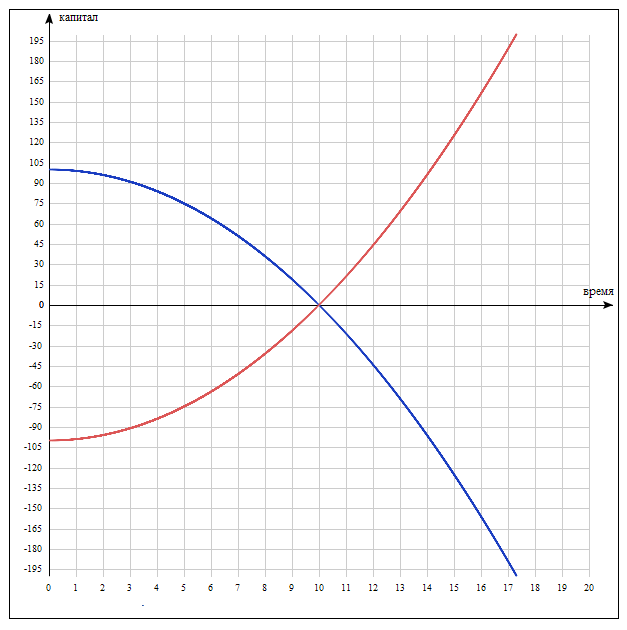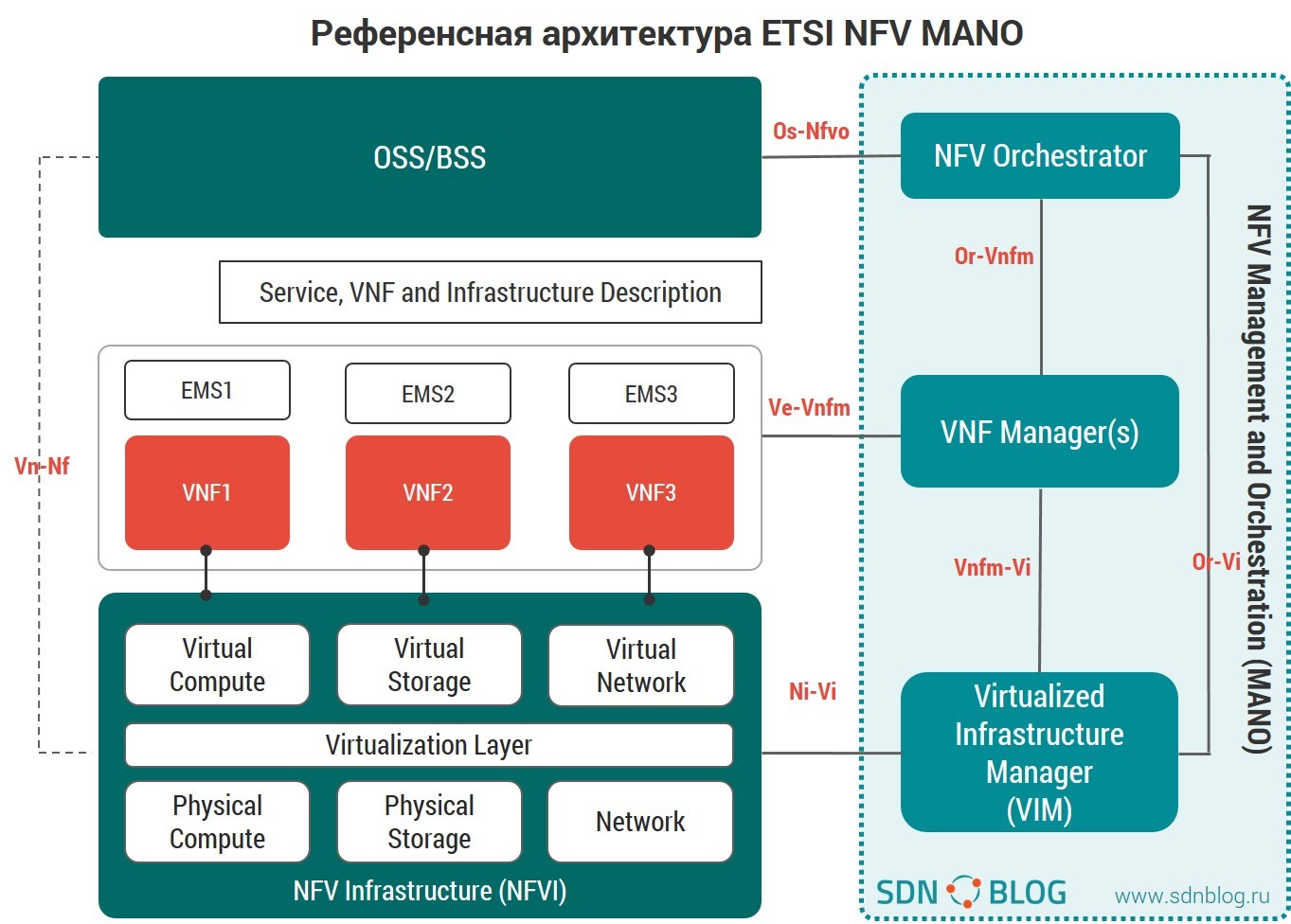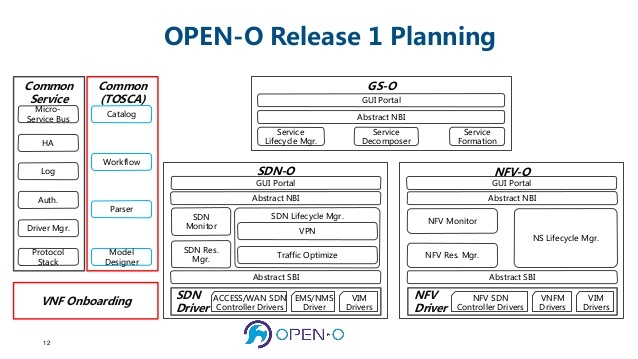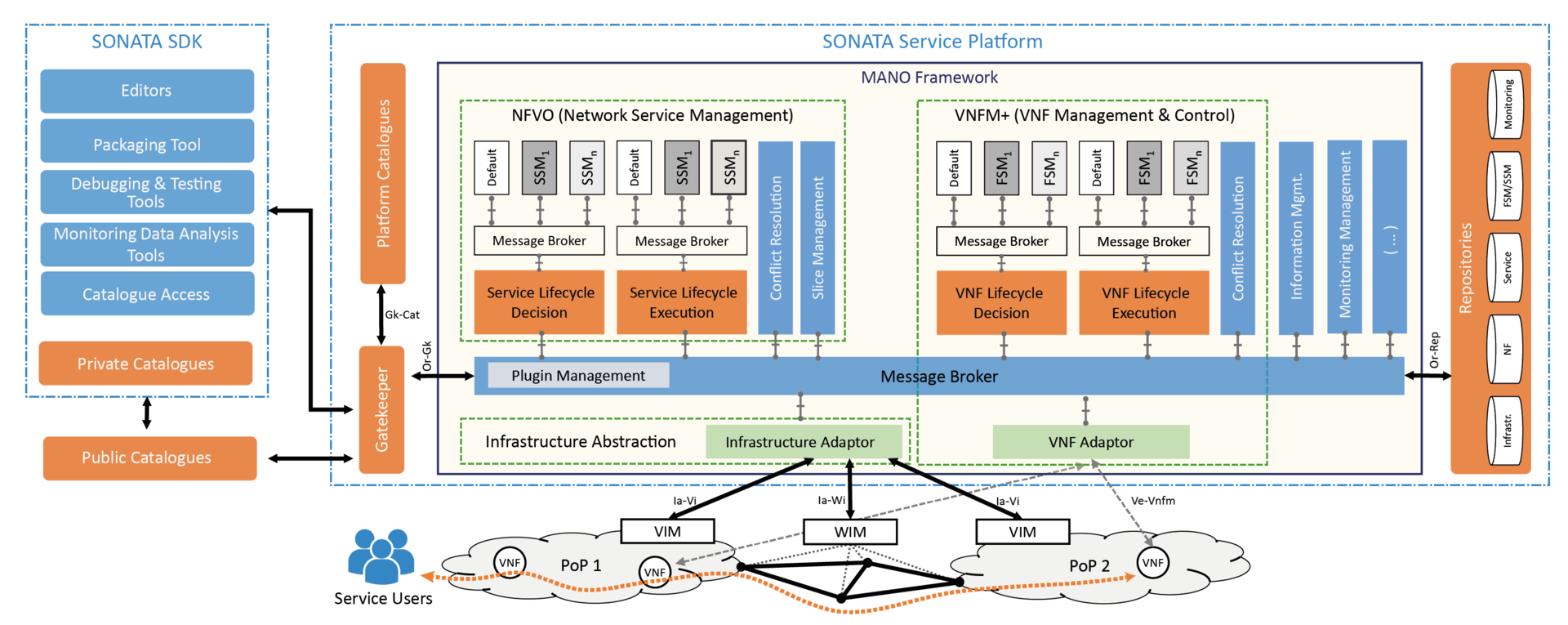NFV MANO Platform Review from the open source community
Introduction
In my last article, we examined the historical context of the development of data transmission networks and the prerequisites that led to the emergence and development of the concepts of SDN and NFV. The economic conclusion for the telecom industry from the article is such that there is a requirement to increase investment in telecom infrastructure and this is due to the requirements for greater bandwidth communication channels. At the same time, there is a tendency to reduce the average revenue per subscriber due to the development of competition and dumping by large operators in an effort to retain market share. These two converging schedules - spending on investments and a decrease in revenues will sooner or later intersect, which will lead to bankruptcies among telecom operators and a redistribution of the market in the direction of consolidation.

To offset this threat, large telecom giants must, on the one hand, increase the return on their investments, and on the other hand, create new services to increase revenue from one subscriber. Both tasks can be accomplished by virtualizing network functions. Tighter use of hardware resources during virtualization has shown its success in the computing capacity market - several virtual machines on one physical server utilize CPU, RAM and Storage much more efficiently. Running multiple virtual network functions on the same hardware server will also reduce capital expenditures on equipment. In addition, it will give flexibility in management, allowing you to quickly update software, fix bugs and launch new services in a short time.
ETSI MANO
To achieve these goals, the NFVI (network function virtualization infrastructure) infrastructure management system is required. This system should be able to automatically run network functions, monitor their status, scale in the event of an increase in load, restart in case of emergency behavior, and terminate if not needed. All this formed the basis of what MANO was called - management and orchestration.
The major players in the telecom industry, realizing the inevitability of movement in this direction, began to coordinate their efforts! This is incredible in the era of capitalism and the closeness of business models that were present in the 20th century, but apparently inevitably in the 21st century, in which the rate of change grows exponentially.
')
It all started with the fact that participants in the telecom market began to create standards by which the software components of this industry should be implemented. Under the auspices of the European Institute for Standardization in the ETSI telecom area, a working group was created to create a whole list of standards describing the most diverse processes of this idea.

The representation of contributors that contribute to the creation of standards is very impressive. Look at the list of participants of the ETSI MANO standard:
NEC, Tech Mahindra, Orange, Cisco, Amdocs, Wind River Systems, Alcatel-Lucent, HP, Oracle, Orange, Juniper, ZTE, Intel, Telecom Italia, Wipro, EnterpriseWeb, NSN, Huawei, ASSIA, Telefonica, China Unicom, AT & T , Verizon, Docomo, Deutsche Telekom, Sprint, Vodafone, 6Wind, BT, tech Mahindra, Sonus, Brocade, ETRI, Ooredoo, Fujitsu, Ericsson.
There are vendors and telecom operators. With such a solid composition, it is obvious that the adopted standards will be implemented both in software components from vendors and on networks of telecom operators. It is worth noting that the work on standards is still ongoing, as the implementation of the set approaches is used to clarify the functional, data format, connecting interfaces, processes and other things. Each contributor has the right (and actively uses it!) To make modifications to the standard. This helps software manufacturers add features they know how to implement in the source code. And it helps operators who know real business cases and how they should be solved with the help of the software being developed.
As a result, the reference architecture of the MANO components was created. We will present it to you in a beautiful picture from wonderful colleagues from sdnblog:

An overview of all components of this architecture, as well as an overview of the entire list of standards being developed, is a topic for a separate article. Colleagues in parallel threads have already made some good reviews of these components ( here and here ).
We, in the framework of this post, are interested in what initiatives have yielded results in an open source environment. Commercial proprietary products of vendors who make money by selling software and licenses to them are difficult to assess from outside, not being inside the market. At the same time, open-source projects are actively discussed and can be studied without being a vendor.
Such projects in the field of ETSI MANO was born a sufficient number:
• Open Source MANO
• Open-O
• SONATA
• OpenBaton
• ECOMP
• OpenStack Tacker
• Gohan
• OPNFV
Let us consider in more detail three of them.
Open Source MANO

Open Source MANO (OSM) is developed by a working group under the leadership of ETSI itself. At the same time, the leading role is occupied by representatives of Telefonica, BT, Telenor and Intel vendors, RITF.io, Ubuntu, VMWare. A full list of contributors can be found here .
The first release of OSM has already taken place and is available for download . Available functionality is represented by the following components:

The OSM architecture now allows for the design of network services, orchestrating network services, managing individual VNFs, and managing NFVI resources allocated for VNFs. An SDN controller connection is available to control the network component necessary to control the traffic that will flow into the VNF.
Since this project is being promoted by ETSI itself, it is likely that it will be one of the most successful.
Open-o

This project is a Chinese response to the trend of creating a network function orchestration system. The list of contributors speaks for itself: China Mobile, China Telecom, Huawei, ZTE, Hong Kong Telecom, Ericsson, Intel, Gigaspaces, Canonical, Infoblox, RedHat. And they don’t be confused by the presence of Western vendors on this list - the leaders are Chinese companies.
The first release has already taken place and is available for download . The functional is represented by the following components:

The architecture allows you to create a virtual flow service using the TOSCA standard, manage networks using an SDN orchestrator and network functions using an NFV orchestrator. Connectors to third-party SDN controllers and NFVI control systems via VIM are available.
It is obvious that the Chinese market of telecom operators will focus on this product and we are unlikely to see the flourishing of other initiatives in this Asian sector. And given the fact that the Chinese mobile and fixed-line market is the largest in the world, it is obvious that many solutions for managing giant data streams in this market can show themselves from the best side. Giant bursts of traffic and working with Big Data from a large number of subscribers will allow to test innovative approaches in this particular market.
SONATA

This project came at the expense of a European grant for R & D in the field of 5G networks called Horizon 2020 - an initiative in which by 2020 5G networks should appear that will increase the data transfer rate for mobile subscribers. At the same time, those services that will be provided to subscribers should have a small delay and wide opportunities. Part of the solution to this problem is the creation of a system of orchestration of communication networks and network functions. The SONATA project was supposed to provide an opportunity for the design of network functions and the operational management of the network functions created.
The project partners include the following companies: Atos, NEC, Thales, Telefonica, Nokia, BT and several European universities. The project itself has a very academic focus and deep development in terms of technology. The focus is on the priority for testing the approaches of the new technological trend, and not the earliest commercial exploitation.
The first release is already available for download , although according to github, it can be seen that the code continues to be in the current first version and, accordingly, this release cannot be called stable.
The functional is represented by the following components:

SONATA SDK allows for service design and testing. The SONATA Service Platform allows you to run created services and manage their life cycle. A description of the architecture is available here (pdf).
What should telecom operators do now?

What can telecom operators, who want to prepare for the next technological trend, do now? Major Western and Asian telecom operators are already completing the piloting stages and proof of concept and are moving to the gradual implementation of these solutions for productive traffic. New sections of the network are equipped with a virtualized network function architecture. New services are designed using the agile approach and based on a distributed infrastructure. In Russia, operators are most often oriented towards solutions that are delivered by Western or Asian vendors that have been tested on already deployed networks. To lead this trend and start introducing innovations among the first in our market is the prerogative of large players, but those who take the new wave first will get the most out of their results through early staff training and finding the best solution for their needs. You can start with piloting those open source projects that are presented in the review. After successful experience in open and free projects, it will be possible to make a choice of a commercial proprietary product, taking into account the fact that often telecom operators concentrate their expertise on operational processes and leave development and support of the solution to a proven vendor. Who to choose from vendors, each operator decides for himself, but reports such as Magic Quadrant by Garnter are often the vector of attention that many consumers of vendor solutions are guided by. Gartner's recent OSS rating shows who supplies the most advanced commercial systems in the industry. It should be noted that under the umbrella of the OSS there are just solutions for managing the NFV infrastructure and the VNF ecosystem:

It can be seen that in the Gartner report, in addition to the "iron" vendors of Nokia, Huawei, HPE, IBM and Ericsson, there are also purely software companies - Netcracker, Amdocs, Oracle. When choosing your vendor, you should keep in mind the interest of the "iron" companies in the sale of their hardware devices in conjunction with the software for the management of "iron". Software companies are deprived of this disadvantage and more often than others are multi-vendor in relation to the "hardware".
At the same time, you can choose a long-term and open source product, but you need to think out on the horizon of 3-5-7 years, who will provide support and write patches for bugfixes.
Source: https://habr.com/ru/post/318320/
All Articles